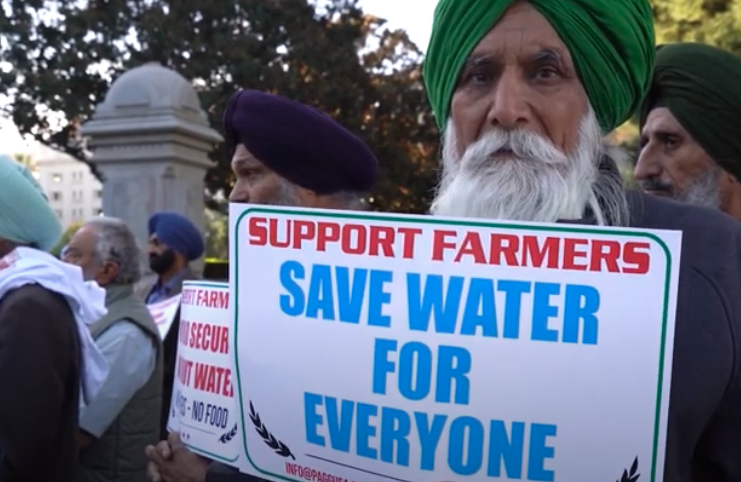As water managers throughout the San Joaquin Valley scramble to reign in groundwater pumping, they’re running into a serious roadblock: angry farmers.
Across the valley, farmers have decried fees and other measures meant to reduce pumping, threatening not to pay, taking agencies to court and protesting groundwater rules.
In some cases, it’s working.
- In the Kaweah subbasin in Kings and western Tulare counties, farmers forced a groundwater agency to cut pumping fees by half.
- In the Chowchilla subbasin farmers voted down groundwater fees and are pursuing creation of their own groundwater agency.
- Just to the south, in Madera County, farmers there won a temporary injunction against county-issued land fees.
- In the Eastern Tule subbasin in Tulare County, farmers voted down a land fee that would have paid off their share of fixing the Friant-Kern Canal, which has sunk as land there has subsided because of excessive groundwater pumping.
The rebellion is a reaction to the state’s Sustainable Groundwater Management Act (SGMA), which aims to bring critically overdrafted water subbasins into balance by 2040.
All subbasins in the San Joaquin Valley are considered critically overdrafted as farmers have leaned more heavily on groundwater to make up for shorter surface supplies from the Sacramento-San Joaquin Delta that have been cut for environmental needs and during two multi-year droughts.
Under SGMA, local water managers, growers and counties were required to form groundwater sustainability agencies (GSAs.) Those agencies are tasked with drafting plans to reduce pumping and replenish aquifers.
And it’s the GSAs taking most of the heat from farmers.
A common thread among growers leading the revolts against fees and other pumping limitations is that they mostly farm in what’s known as “white areas” or “white lands.”
White areas are outside of water district boundaries. Growers in white areas rely almost entirely on groundwater and have never paid district fees and assessments used to build infrastructure such as canals and recharge basins and to buy surface water.
Without funding from fees, it’s unclear how the GSAs will pay for projects such as incentives to retire farmland, building water recharging facilities, buying surface water and fixing drinking wells dried up from dropping water tables.
Last gasp
The farmer reaction is disheartening but not completely unexpected to those in the trenches.
“I think it’s just the last gasp of some people who just have this mindset that this is wrong. And they don’t want to have to deal with it,” said Sargeant Green, project director for the California Water Institute. “Everybody who was rational at all understands that we could not keep going on the way we were going.”
Farmers have said the fees aren’t sustainable and would put many people out of business. That may be true for some, said Green. Especially those who bought land in the last 5-10 years to hit it big in almonds, which have plummeted in price recently.
“Those are the people that are probably going to yell the loudest that this is going to hurt them and maybe put them over the edge. But farming has always been a gamble,” said Green. “Baked into that is the fact that they have been on borrowed time, even on the groundwater. If they kept pumping they would have been out of business too.”
Farmers involved in the disputes say they understand the stakes very well and that they aren’t simply throwing wrenches into the process to forestall the inevitable.
“We’re not sitting here just saying no, and trying to fight and threaten. We want to be part of the solution,” said Dino Giacomazzi, treasurer for the Delta View Water Association, a voluntary organization formed in 2019 that is separate from GSAs. Delta View has about 85 members in the Tulare/Kings county area representing farms over 100,000 acres of white lands.
Pushing back
Delta View actions have been instrumental in pushing back on fees from the Greater Kaweah GSA. Greater Kaweah covers a large swath of white areas.
In September, the Greater Kaweah board went into a closed session meeting and came out with much higher water fees than the farmers had expected, Giacomazzi said.
The proposed fees were $125 per acre foot of overdrafted water for “tier 1” overdraft and $250 per acre feet for the next tier of overdraft.
“We were just flabbergasted,” said Johnny Gailey, consultant to the Delta View Water Association. “Everybody was sitting there just like, ‘whoa, what just happened?’ No public input, nothing.”
About 150 farmers showed up at the next meeting to protest and the Greater Kaweah board cut the fees down to $60 per acre foot and $120 per acre foot for tier 1 and tier 2 respectively.
It’s unclear now, how Greater Kaweah will pay to fix any damaged drinking water wells, something the Department of Water Resources required in its evaluation of the GSA’s groundwater plan.
Meanwhile, Greater Kaweah is working with Delta View on a “reverse auction” fallowing program, proposed by the Delta View farmers. The program would allow farmers who want to fallow land to submit bids for how much they’d want to be paid per acre. The GSA could then accept the most affordable bids.
“I think there’s been some good collaboration,” said Mark Larsen, general manager of the Greater Kaweah GSA. “I think we’re working together better than we were and I think there’s some good potential.”
Punitive versus collaborative
Still, growers seem to view SGMA fundamentally differently than GSA managers.
When the Greater Kaweah board was discussing penalty fees for overpumping, there were times when the fee was seen as not punitive enough.
“We discovered at that point that their view of sustainability was about being punitive,” said Giacomazzi. “And our view of sustainability is about being collaborative and using math to figure out how to get there.”
In Madera County, established GSAs are also seeing groups of farmers splinter off to form their own groups.
The county GSA oversees all the white areas in the Madera, Chowchilla and Delta-Mendota subbasins.
When it held an election, called a Proposition 218 election, on groundwater fees last June, a majority of farmers in the Chowchilla subbasin voted the fees down. Farmers in the other two subbasins approved the fees.
“One thing that’s really frustrating is I felt like we did a ton of outreach with Prop 218,” said Stephanie Anagnoson, director of water and natural resources for Madera County.
The county GSA held meetings ahead of the vote every month, both in person and online. There was a group of growers who worked consistently with the county on the process, and while they didn’t like it, they understood the math behind the fees and the necessity to pay for future water projects, said Anagnoson.
“But then there was a group of people who chose not to pay attention,” said Anagnoson.
Those people got involved within the last 45 days before the vote, she added. They wanted to make many changes to the rate. But it was too late for changes.
Paying their share
“I think maybe in the construction of SGMA, people underestimated the trouble of getting people who hadn’t been paying for something (water and infrastructure) to pay,” said Anagnoson. “It’s a difficult thing to explain.”
Growers in the Chowchilla subbasin plan to form their own GSA. That process could take years.
The groundwater fee rejection in Chowchilla was just the start for Madera County.
Farmers throughout the Madera County GSA then sued the county over a $246 per farm unit acre fee, which is different from groundwater pumping fees.
On December 7, a judge granted a temporary injunction prohibiting the county from collecting the $246-fee and will hear the full case later. That means SGMA fees are paused for now and projects will have no funding until the injunction is lifted.
In the Eastern Tule GSA, managers had planned to institute a $140-per-acre land fee to help pay off farmers’ share of the cost to fix the sagging Friant-Kern Canal. The fee would have provided enough funding to pay a lump sum of $125 million toward the fix. However, farmers rejected the fee in an election held last July.
Without it, farmers are now on the hook for $200 million to be paid over time through fees attached to groundwater pumping. However, there are questions about how many groundwater credits farmers are afforded.
Share this:
- Click to share on Facebook (Opens in new window)
- Click to share on Twitter (Opens in new window)
- Click to share on LinkedIn (Opens in new window)
- Click to share on Reddit (Opens in new window)
- Click to share on Tumblr (Opens in new window)
- Click to share on Pinterest (Opens in new window)
- Click to share on Pocket (Opens in new window)
- Click to share on Telegram (Opens in new window)
- Click to share on WhatsApp (Opens in new window)
- Click to print (Opens in new window)








